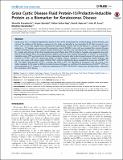| dc.contributor.author | Priyadarsini, Shrestha | en_US |
| dc.contributor.author | Hjortdal, Jesper | en_US |
| dc.contributor.author | Sarker-Nag, Akhee | en_US |
| dc.contributor.author | Sejersen, Henrik | en_US |
| dc.contributor.author | Asara, John M. | en_US |
| dc.contributor.author | Karamichos, Dimitrios | en_US |
| dc.date.accessioned | 2014-12-02T21:28:50Z | |
| dc.date.issued | 2014 | en_US |
| dc.identifier.citation | Priyadarsini, Shrestha, Jesper Hjortdal, Akhee Sarker-Nag, Henrik Sejersen, John M. Asara, and Dimitrios Karamichos. 2014. “Gross Cystic Disease Fluid Protein-15/Prolactin-Inducible Protein as a Biomarker for Keratoconus Disease.” PLoS ONE 9 (11): e113310. doi:10.1371/journal.pone.0113310. http://dx.doi.org/10.1371/journal.pone.0113310. | en |
| dc.identifier.issn | 1932-6203 | en |
| dc.identifier.uri | http://nrs.harvard.edu/urn-3:HUL.InstRepos:13454788 | |
| dc.description.abstract | Keratoconus (KC) is a bilateral degenerative disease of the cornea characterized by corneal bulging, stromal thinning, and scarring. The etiology of the disease is unknown. In this study, we identified a new biomarker for KC that is present in vivo and in vitro. In vivo, tear samples were collected from age-matched controls with no eye disease (n = 36) and KC diagnosed subjects (n = 17). Samples were processed for proteomics using LC-MS/MS. In vitro, cells were isolated from controls (Human Corneal Fibroblasts-HCF) and KC subjects (Human Keratoconus Cells-HKC) and stimulated with a Vitamin C (VitC) derivative for 4 weeks, and with one of the three transforming growth factor-beta (TGF-β) isoforms. Samples were analyzed using real-time PCR and Western Blots. By using proteomics analysis, the Gross cystic disease fluid protein-15 (GCDFP-15) or prolactin-inducible protein (PIP) was found to be the best independent biomarker able to discriminate between KC and controls. The intensity of GCDFP-15/PIP was significantly higher in healthy subjects compared to KC-diagnosed. Similar findings were seen in vitro, using a 3D culture model. All three TGF-β isoforms significantly down-regulated the expression of GCDFP-15/PIP. Zinc-alpha-2-glycoprotein (AZGP1), a protein that binds to PIP, was identified by proteomics and cell culture to be highly regulated. In this study by different complementary techniques we confirmed the potential role of GCDFP-15/PIP as a novel biomarker for KC disease. It is likely that exploring the GCDFP-15/PIP-AZGP1 interactions will help better understand the mechanism of KC disease. | en |
| dc.language.iso | en_US | en |
| dc.publisher | Public Library of Science | en |
| dc.relation.isversionof | doi:10.1371/journal.pone.0113310 | en |
| dc.relation.hasversion | http://www.ncbi.nlm.nih.gov/pmc/articles/PMC4236164/pdf/ | en |
| dash.license | LAA | en_US |
| dc.subject | Biology and Life Sciences | en |
| dc.subject | Biochemistry | en |
| dc.subject | Biomarkers | en |
| dc.subject | Cell Biology | en |
| dc.subject | Medicine and Health Sciences | en |
| dc.subject | Ophthalmology | en |
| dc.subject | Visual Impairments | en |
| dc.subject | Blindness | en |
| dc.subject | Corneal Disorders | en |
| dc.subject | Biological Cultures | en |
| dc.subject | Tissue Cultures | en |
| dc.title | Gross Cystic Disease Fluid Protein-15/Prolactin-Inducible Protein as a Biomarker for Keratoconus Disease | en |
| dc.type | Journal Article | en_US |
| dc.description.version | Version of Record | en |
| dc.relation.journal | PLoS ONE | en |
| dash.depositing.author | Asara, John M. | en_US |
| dc.date.available | 2014-12-02T21:28:50Z | |
| dc.identifier.doi | 10.1371/journal.pone.0113310 | * |
| dash.contributor.affiliated | Asara, John | |


